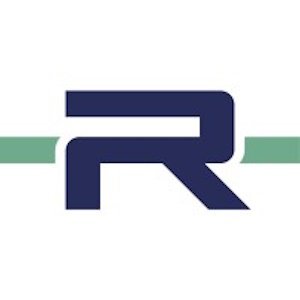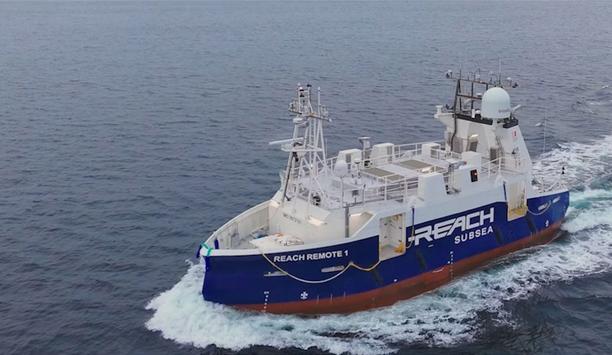Reach Subsea - Experts & Thought Leaders
Latest Reach Subsea news & announcements
A new era of offshore operations has begun with the successful delivery of REACH REMOTE 1, a 24-metre unmanned surface vessel (USV) designed by Kongsberg Maritime. This ground-breaking achievement marks a significant milestone through collaboration between Kongsberg Maritime, REACH SUBSEA ASA, Massterly, and Trosvik Maritime. Intensive sea trials Designed to revolutionise offshore operations, the REACH REMOTE 1 is packed with cutting-edge KONGSBERG technology. Its delivery follows a programme of intensive sea trials, overseen by the classification society Det Norske Veritas (DNV) and the Norwegian Maritime Authority. Its initial mission will be to conduct underwater surveys off the coast of Haugesund, Norway, but its potential applications extend far beyond this. The second vessel, REACH REMOTE 2 is now expected to begin sea trials. Responsibility for vessel design Kongsberg Maritime served as the prime contractor for this turnkey project for vessel design Bjørg Mathisen Døving, Vice President (VP) - Reach Remote of REACH SUBSEA, said: “Reach Remote is an extraordinary journey, bringing together the unique expertise of Kongsberg Maritime, Reach Subsea, and Massterly shaping the future of uncrewed offshore operations. We are thrilled to see the Reach Remote 1 set sail and prepared for its first mission.” Kongsberg Maritime served as the prime contractor for this turnkey project, taking responsibility for vessel design, yard delivery, supply chain management, systems integration, and commissioning. The company’s deep expertise in maritime technology was instrumental in bringing this innovative concept to life. Future of offshore activities “What began as a visionary idea has now become a tangible reality,” said Lisa Edvardsen Haugan, President of Kongsberg Maritime. Lisa Edvardsen Haugan adds, “The REACH REMOTE 1USV is a testament to our commitment to pushing the boundaries of maritime technology. We are proud to have partnered with REACH SUBSEA, Massterly and Trosvik Maritime on this pioneering project. As the world transitions towards more sustainable and efficient operations, this pioneering class of vessel is poised to play a vital role in shaping the future of offshore activities.” Key feature of the REACH REMOTE USV design A key feature of the REACH REMOTE USV design is its ability to operate without a crew remotely from the ROC During the sea trials, the USV was monitored and controlled from a temporary, mobile Remote Operations Centre (ROC) located onboard a support vessel Avant, which stayed close by during several days of trials. When the USV starts pilot operations, Massterly, which is a joint venture between Kongsberg Maritime and Wilhelmsen, will control the USV from the land-based ROC in Horten, Norway. A key feature of the REACH REMOTE USV design is its ability to operate without a crew, controlled remotely from the ROC. This approach offers significant advantages in terms of operating costs, safety, and emissions, when compared to carrying out the same duties with a much larger, crewed vessel. Regulatory challenges with uncrewed vessels To ensure the highest levels of safety and reliability, Kongsberg Maritime has incorporated proven technology into the vessel's design. The company worked closely with Det Norske Veritas (DNV) and the Norwegian Maritime Authority to navigate the unique regulatory challenges associated with uncrewed vessels. Increased remote and autonomous functionality will be gradually introduced in a stepwise approach pending technology readiness.
At the SMM trade fair, DNV celebrated three advances in the ongoing development and deployment of autonomous technologies in shipping. Ocean Infinity was awarded a Statement of Compliance, while Avikus and Reach Subsea received certificates recognising their ongoing collaborations with DNV. Autonomous shipping Autonomous shipping covers many aspects of shipping’s new technological landscape – everything from systems to aid decision-making, control speed, and direction, remote controlled operation, and fully unmanned vessels. This evolution is still in its early stages, however, making close collaboration between stakeholders essential to realising the potential gains in safety, efficiency, and sustainability. Shipping efficiency and safety Knut Ørbeck-Nilssen, CEO of DNV Maritime, said, "As the maritime industry becomes more technologically advanced, DNV is committed to collaborating with industry pioneers to enhance the efficiency and safety of shipping." He adds, "In the absence of a regulatory scheme for the industry, we are developing guidelines and class notations that have been designed to evolve with the rapid advancements in autonomous technologies." Statement of Compliance Ocean Infinity’s vessel concept as the first fleet to reach the required standard of technology and operations At the SMM Trade Fair, Ocean Infinity was awarded a Statement of Compliance for its remotely supported vessel operations. Receiving this approval establishes Ocean Infinity’s vessel concept as the first fleet to reach the required standard of technology and operations for large vessels, and permits the beginning of onshoring marine-related tasks and activities. Innovation and technology Oliver Plunkett, CEO at Ocean Infinity, said, "Since we started the business, Ocean Infinity has been about innovation, technology, and pushing the boundaries in the maritime industry." He adds, "This is a significant achievement for the team. My congratulations go to them all, as well as those who have worked with them and contributed at DNV and Vard, our shipbuilder." Technology-driven progress Oliver Plunkett continues, "As we deliver our services to our customers, we are continually balancing the need for technology-driven progress with safely bringing them solutions." He further said, "Our approach is to pioneer with speed but not haste, becoming the first organisation to receive this Statement of Compliance is a testament to that. I am looking forward to watching as we begin to put our ideas of onshoring marine activities and tasks into practice." HiNAS decision support system HiNAS assists navigators by enabling ships to avoid collisions while maintaining optimal routes and speeds During day two of SMM, Avikus, HD Hyundai’s ship autonomous navigation subsidiary, and DNV celebrated the start of the test phase for the HiNAS decision support system. HiNAS assists navigators by enabling ships to avoid collisions while maintaining optimal routes and speeds. After receiving a DNV design verification report (DVR) in September 2023, the new testing phase plays an important role in the Type Approval process for the HiNAS decision support system. Autonomous navigation solutions Dohyeong Lim, CEO of Avikus, said, "We are excited to be working towards the first Type Approval for autonomous navigation solutions under DNV’s regulations, a pioneering maritime classification society." He adds, "As this is a world-first initiative, we are navigating unexpected challenges, but our close collaboration is establishing verification standards and methodologies." Maritime Autonomous Surface Ships (MASS) Dohyeong Lim continues, "This milestone is significant for both DNV, which is at the forefront of setting international standards for Maritime Autonomous Surface Ships (MASS), and Avikus, which is advancing and commercialising autonomous navigation technology." He further said, "Avikus will continue to support DNV’s efforts and collaborate across various areas to further develop and approve this technology." Reach Remote Reach is working towards a certification that will enable full autonomy in the future Another project sees Reach Subsea, working with DNV on the testing of the 'Reach Remote', their DNV-classed 24m unmanned survey vessel, which is designed to be operated remotely from its deployment. While the vessel is currently remotely operated from a mothership, Reach is working towards a certification that will enable full autonomy in the future. At SMM, the parties celebrated the ongoing cooperation and reflected on the potential of the uncrewed operations to revolutionise offshore subsea operations. Marine technology project Bjørg Mathisen Døving, Vice President at Reach Remote, said, "Reach Remote is a groundbreaking marine technology project that has demanded significant effort from everyone involved." He adds, "With no rules to steer towards, DNV's role has been valuable, also to me personally on how to navigate in a complex and uncharted environment." Additional class notation DNV has developed an additional class notation focused on autonomous and remotely operated ships (AROS), providing a framework for how auto-remote vessels can achieve equivalent or higher safety compared to conventional vessels. The notation, which is currently on hearing, applies functional requirements combined with a risk-based approach to assess the various possibilities of autonomous and remotely operated vessel concepts. DNV-CG-0264 The AROS notation is a result of many years of lessons learned by using the DNV-CG-0264 (class guidelines for autonomous and remotely operated ships) to evaluate autonomous ship concepts in collaboration with many innovative companies worldwide. DNV-CG-0264, initially launched in 2018, has also been updated to include the knowledge acquired with real-life projects. The new edition of the class guideline is also on hearing.
REACH Subsea’s ground-breaking uncrewed surface vessel, REACH REMOTE 1, has received the Skipsrevven Ship of the Year 2024 award at the SMM exhibition in Hamburg. The 24-metre REACH REMOTE 1 is the first of a pair of uncrewed offshore surface vessels designed and delivered by Kongsberg Maritime to Norwegian company REACH SUBSEA ASA. REACH REMOTE USV design Crammed with state-of-the-art KONGSBERG technology, the vessels will initially carry out underwater survey duties off the coast of Haugesund in southern Norway, and with global interest in this disruptive approach to traditional duties, many more are set to follow. A key feature of the REACH REMOTE USV design is its ability to operate without a crew, controlled remotely. This approach offers significant advantages in terms of operating costs, safety, and emissions, when compared to carrying out the same duties with a much larger, crewed vessel. Range of technologies Kongsberg Maritime has taken on the role of prime contractor, with firm also liable for vessel design In a unique approach to delivery, Kongsberg Maritime has taken on the role of prime contractor, with the company also responsible for vessel design, REACH REMOTE is a true turnkey project. Packed with a range of technologies, this pioneering project has involved a range of companies including KONGSBERG, REACH Subsea, Trosvik Maritime AS, Massterly, DNV, Kystdesign and the Norwegian Maritime Authorities (NMA). REACH REMOTE vessels Lisa Edvardsen Haugan, President – Kongsberg Maritime, said, “We are extremely proud to have played such a pivotal role in this project and are absolutely delighted to have been recognised alongside our valued partners at REACH Subsea for the innovation and cutting-edge technology that makes the REACH REMOTE vessels such a gamechanger for our industry.” Speaking at the award ceremony, COO of Reach Subsea, Inge Grutle said: “We are very proud to be awarded the Ship of the Year award for our first uncrewed vessel, the Reach Remote 1, which we are confident will be the first in a series of many to support our ambition to give our clients sustainable access to the ocean space”. Reach Remote project Reach Subsea CEO, Jostein Alendal, said: “To revolutionise an industry, you need to innovate. To innovate you need people within the organisation and partners alongside you who can think big, think differently, and overcome the challenges that arise along the way. The Reach Remote project is a powerful testament to this, and I am immensely proud to see that what were once bold ideas are now coming to life.” “We are committed to seeing this through to full operation. Winning the Ship of the Year award is a tremendous boost and a great source of motivation for our teams. We look forward to continuing the great cooperation established with KONGSBERG and Massterly as we scale up Reach Remote vessels in the future.” UT 5208 USV vessels ROV will feature a robust robotic arm to enable simple underwater tasks, such as adjusting valves Reach Subsea’s Vice President of Reach Remote, Bjørg Mathisen Døving, added: “To be part of such a ground-breaking project has been a joyride and I have had the time of my life. I am so proud of the unstoppable efforts from the diverse teams, and I truly believe this project is a lighthouse for the industry”. The UT 5208 USV vessels are designed for uncrewed subsea operations. KONGSBERG is providing the handling equipment for the ROV, as well as hull-mounted sensors for survey work. The ROV will feature a robust robotic arm to enable simple underwater tasks, such as adjusting valves or moving debris. The vessels will be controlled from a remote operations centre where one captain will be able to control several vessels at the same time. REACH REMOTE fleet Massterly, which is a joint venture between Kongsberg Maritime and Wilhelmsen, will monitor and control the vessels from its Remote Operations Centre (ROC) in Horten, Norway. REACH Subsea has responsibility for all the client interfaces and its teams will operate ROVs from their Operations Centre. Initially, this will be based in Haugesund but this capability can be deployed globally through a network mobile, container-based Operations Centres, as the REACH REMOTE fleet expands. For the initial deployment, the vessels will be followed by a support vessel in the early stages of operation, before transitioning to remote and autonomous control.






